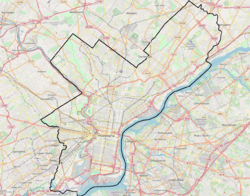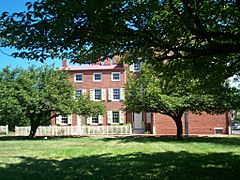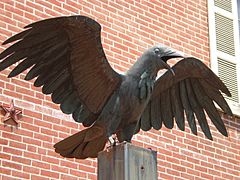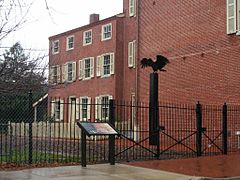Edgar Allan Poe National Historic Site facts for kids
|
Edgar Allan Poe House
|
|
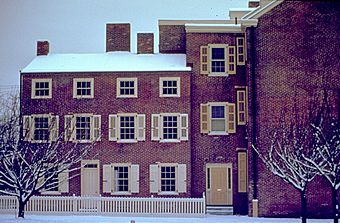
Poe lived in the smaller section on the left; the larger section was built later and now serves as the building's entrance and visitor center.
|
|
| Location | 532 N. 7th St., Philadelphia, Pennsylvania |
|---|---|
| Built | 1842 |
| Architect | William Alburger, John Evans |
| Website | Edgar Allan Poe National Historic Site |
| NRHP reference No. | 66000689 |
Quick facts for kids Significant dates |
|
| Added to NRHP | October 15, 1966 |
| Designated NHL | December 29, 1962 |
The Edgar Allan Poe National Historic Site is a special house in Philadelphia, Pennsylvania. It was once rented by the famous American writer Edgar Allan Poe. This historic home is located at 532 N. 7th Street in the Spring Garden area. Poe lived in many houses in Philadelphia between 1837 and 1844. However, this is the only one that is still standing today. Because of its importance, it was named a National Historic Landmark in 1962.
Contents
Poe's Time in Philadelphia
Edgar Allan Poe lived in Philadelphia for about five years. This was from 1837 to 1844. During this time, he lived in several different homes. These included houses on Arch Street and Sixteenth Street. He also lived on Coates Street.
Poe's Famous Works
While in Philadelphia, Poe wrote some of his most well-known stories. These include "The Tell-Tale Heart" and "The Murders in the Rue Morgue." He also wrote "The Gold-Bug." Many people say this was his most creative period. In total, Poe published 31 stories during these years. He also wrote many reviews of other books.
Poe and Charles Dickens
One famous review was in February 1841. It was about Charles Dickens's novel Barnaby Rudge: A Tale of the Riots of 'Eighty. Poe was so good at understanding the story that he guessed the ending. He did this before the last part of the book was even published! Dickens was very surprised by this. Poe's time in Philadelphia is often called the happiest part of his life.
History of the Poe Home
The Edgar Allan Poe National Historic Site is the only one of Poe's Philadelphia homes that still exists. It is in the northern part of Philadelphia. Poe rented this house in early 1843. He lived there for about a year or less. His wife, Virginia, lived with him. His aunt and mother-in-law, Maria Clemm, also lived there.
Life in the House
We are not sure exactly when the family moved in. It was likely before June 1843. The house was then at the corner of Seventh Street and Brandywine Alley. We don't know for sure which stories Poe wrote in this house. But some guesses include "A Tale of the Ragged Mountains" and "The Balloon-Hoax." The poem "Eulalie" might also have been written here.
The neighborhood around the house was mostly Quakers. Virginia Poe was sick with tuberculosis. This might have been why the family moved. Maria Clemm, Poe's mother-in-law, took care of the home. A neighbor remembered her always working hard. She would clean the yard and wash the windows. She even painted the fence white. The house was described as very clean and tidy.
Poe sometimes had trouble paying the rent. But the landlord, who was a plumber, was understanding. The family moved out in April 1844. They then moved to New York.
From Private Home to Museum
After Poe left, several other families lived in the house. Then, in 1933, Richard Gimbel bought it. He was the son of the person who started the Gimbels department store. Richard Gimbel was a big fan of Poe. He fixed up the house and opened it as a museum.
When he passed away, he left the house to the city of Philadelphia. The National Park Service started taking care of the property in 1978. They reopened the home to visitors in 1980.
The Poe Home Today
The site includes Poe's old house and two other houses next to it. These other houses were built after Poe moved away. The rooms in Poe's house are kept as they were found. They are not furnished to look exactly like Poe's time. This is called "arrested decay."
Visitor Experience
The neighboring buildings have a welcome area and a gift shop. There is also a room where you can watch a film. You can also see some small exhibits there. The site also has a special reading room. This room is decorated based on Poe's ideas from his essay "The Philosophy of Furniture." This is the only room on the site that looks like it's from the 19th century. But it's not part of Poe's original home. It's not meant to show how Poe's own room looked.
The reading room has a full collection of Poe's writings. You can also listen to audio versions of his work. Outside the home, there is a large statue of a raven. This bird represents Poe's very famous poem, "The Raven" (written in 1845). The cellar in the house looks like the one described in Poe's story "The Black Cat" (written in 1843). This story was also written while Poe lived in Philadelphia.
The house does not have any items that belonged to the Poe family. However, many of Poe's belongings are kept nearby. They are at the Free Library of Philadelphia.
Visiting Information
The site is connected with the Independence National Historical Park. You can visit the Edgar Allan Poe National Historic Site from Friday to Sunday. It is open from 9 AM to 5 PM, but closed for lunch from Noon to 1 PM. You can take a self-guided tour anytime. Guided tours are also available; you can call for times. There is no cost to enter the site. You can also become a member of the Friends of Poe Society. This helps keep the home in good condition. The society also hosts events throughout the year.
Photo gallery
-
530-532 N. 7th St., Philadelphia, Pennsylvania, USA


